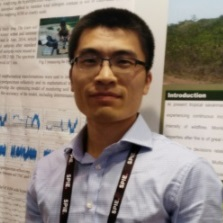Estimation of Crop Phenotyping Traits using Unmanned Ground Vehicle and Unmanned Aerial Vehicle Imagery
A special issue of Remote Sensing (ISSN 2072-4292). This special issue belongs to the section "Remote Sensing in Agriculture and Vegetation".
Deadline for manuscript submissions: closed (31 December 2018) | Viewed by 261071
Special Issue Editors
Interests: hyperspectral and multispectral remote sensing; crop models; data assimilation; crop phenotyping traits; UAV-based sensors; UGV-based sensors; precision farming
Interests: remote sensing; crop growth model; crop yield and quality predicting; precision agriculture; agronomy
Special Issues, Collections and Topics in MDPI journals
Interests: remote sensing of vegetation with focus on time series analysis and use of physically based radiative transfer models for mapping biochemical and biophysical traits
Special Issues, Collections and Topics in MDPI journals
Special Issue Information
Dear Colleagues,
To meet the global food security challenges under changing climatic scenarios, it is most important to enhance crop yield under resource competence. Accurate and precise measurements of crop phenotyping traits play an important role in harnessing the potentiality of genomic resources in the genetic improvement of crop yield. In traditional crop phenotyping, traits are assessed with statistical analysis methods, which must be done manually. Human effort, time, and resources are needed to measure plant characteristics. With the fast development of Unmanned Ground Vehicle (UGV), Unmanned Aerial Vehicle (UAV), sensor technologies, and image algorithms, the integration of UGV, UAV, sensors and algorithmic applications for automatic crop phenotyping are being handled to overcome the defects of manual techniques. These high-throughput non-invasive crop phenotyping platforms have been used to estimate LAI, canopy cover, nitrogen, chlorophyll, biomass, plant structure, plant density, phenology, leaf health, canopy/leaf temperature, and the physiological state of photosynthetic machinery under different stress conditions. They have become much more advanced in order to provide a solution to genomics-enabled improvements and address our need of precise and efficient phenotyping of crop plants. They will also help in finding more relevant solutions for the major problems that are currently limiting crop production.
This Special Issue is focused on the latest innovative research results in the field of remote sensing technology, senor technologies, and imagery algorithm development and applications specifically addressing issues estimating the crop phenotyping traits based on UGV and UAV imagery. The list below provides a general (but not exhaustive) overview of the topics that are solicited for this Special Issue:
Ø UGV and UAV platforms application for crop phenotyping traits
Ø Imagery algorithms (data fusion, segmentation, classification, machine learning, and deep learning, etc.) to estimate crop phenotyping traits
Ø Sensors (RGB, multispectral, hyperspectral, thermal, Lidar, fluorescence, etc.) application for crop phenotyping traits
Ø Combination of different sensors data to improve the estimation accuracy of crop phenotyping traits
Ø Data assimilation of multisource images into two- or three-dimensional crop models
Dr. Xiuliang Jin
Dr. Zhenhai Li
Prof. Dr. Clement Atzberger
Guest Editors
Manuscript Submission Information
Manuscripts should be submitted online at www.mdpi.com by registering and logging in to this website. Once you are registered, click here to go to the submission form. Manuscripts can be submitted until the deadline. All submissions that pass pre-check are peer-reviewed. Accepted papers will be published continuously in the journal (as soon as accepted) and will be listed together on the special issue website. Research articles, review articles as well as short communications are invited. For planned papers, a title and short abstract (about 100 words) can be sent to the Editorial Office for announcement on this website.
Submitted manuscripts should not have been published previously, nor be under consideration for publication elsewhere (except conference proceedings papers). All manuscripts are thoroughly refereed through a single-blind peer-review process. A guide for authors and other relevant information for submission of manuscripts is available on the Instructions for Authors page. Remote Sensing is an international peer-reviewed open access semimonthly journal published by MDPI.
Please visit the Instructions for Authors page before submitting a manuscript. The Article Processing Charge (APC) for publication in this open access journal is 2700 CHF (Swiss Francs). Submitted papers should be well formatted and use good English. Authors may use MDPI's English editing service prior to publication or during author revisions.
Keywords
- crop phenotyping traits
- unmanned ground vehicle
- unmanned aerial vehicle imagery
- imagery algorithms
- segmentation
- classification
- machine learning
- different sensors data
- data assimilation
- two or three dimensional crop models
Benefits of Publishing in a Special Issue
- Ease of navigation: Grouping papers by topic helps scholars navigate broad scope journals more efficiently.
- Greater discoverability: Special Issues support the reach and impact of scientific research. Articles in Special Issues are more discoverable and cited more frequently.
- Expansion of research network: Special Issues facilitate connections among authors, fostering scientific collaborations.
- External promotion: Articles in Special Issues are often promoted through the journal's social media, increasing their visibility.
- e-Book format: Special Issues with more than 10 articles can be published as dedicated e-books, ensuring wide and rapid dissemination.
Further information on MDPI's Special Issue policies can be found here.







